Related Research Articles
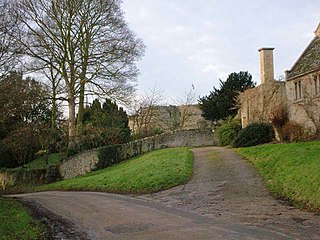
Barnwell Castle is a ruined castle, south of the town of Oundle, and north of the village of Barnwell, Northamptonshire. It has been designated by English Heritage as a Grade I listed building, and is a Scheduled Ancient Monument. It is under private ownership.

Cottingham is a large village and civil parish in the East Riding of Yorkshire, England. It lies 4 miles (6 km) north-west of the centre of Kingston upon Hull, and 6 miles (10 km) south-east of Beverley on the eastern edge of the Yorkshire Wolds. It forms part of Hull's Urban Area. It has two main shopping streets, Hallgate and King Street, which cross each other near the Church of Saint Mary the Virgin, and a market square called Market Green. Cottingham had a population of 17,164 residents in 2011, making it larger by area and population than many towns. As a result, it is one of the villages claiming to be the largest village in England.
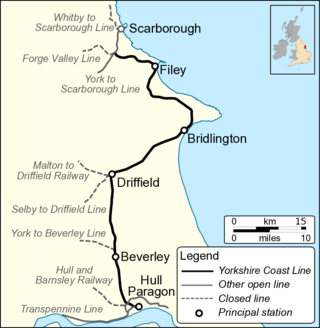
The Hull–Scarborough line, also known as the Yorkshire Coast Line, is a railway line in Yorkshire, England that is used primarily for passenger traffic. It runs northwards from Hull Paragon via Beverley and Driffield to Bridlington, joining the York–Scarborough line at a junction near Seamer before terminating at Scarborough railway station.

Buttercrambe with Bossall is a civil parish in North Yorkshire, England. The parish had a population of 100 according to the 2001 census, increasing to 105 at the 2011 census. The parish is near Stamford Bridge, and contains Buttercrambe and Bossall.
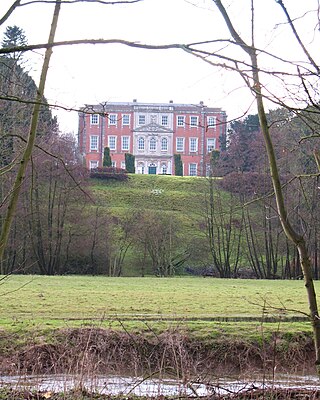
Aldby Park is a country estate in the village of Buttercrambe near the village of Stamford Bridge in the East Riding of Yorkshire, England.
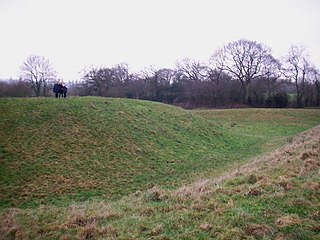
Shotwick Castle is a Norman medieval fortification near the village of Saughall, Cheshire, England. Construction began in the late 11th century. Its purpose was to control a crossing point on the River Dee between England and Wales. The site is a scheduled monument. No masonry features remain above ground except for earthworks.
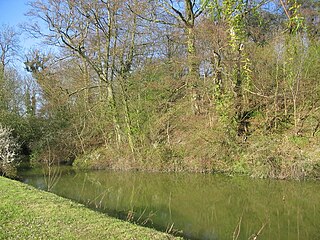
Anstey Castle was in the village of Anstey, Hertfordshire. It was a 12th-century stone motte and bailey fortress that, according to tradition, was founded by Eustace II, Count of Boulogne. It was either him, or one of his immediate progeny who established the first earthwork castle here. The castle had most probably been in existence for some time when the estate was acquired by Geoffrey de Mandeville, for he sought to strengthen his estate in the surrounding valley. It passed into the hands of the de Anstey family in the middle of the 12th century and was strengthened during the First Barons' War of 1215–1216 by Nicholas de Anstey, an opponent of King John, fighting for the barons. After the war ended de Anstey was commanded in 1218 to destroy the castle, with only those parts to remain that had been built before the war. The material from this demolition was supposed to be used in order to repair the nearby church, therefore the crest and shield from the castle feature in the church graffiti.

Bakewell Castle was in the town of Bakewell, Derbyshire.

Barwick-in-Elmet Castle was a fortification in the village of Barwick-in-Elmet, West Yorkshire, England to the east of Leeds.

Bourne Castle was a castle in the market town of Bourne in southern Lincolnshire.

Burton in Lonsdale Castle was in the village of Burton in Lonsdale in North Yorkshire, England.

Chartley Castle lies in ruins to the north of the village of Stowe-by-Chartley in Staffordshire, between Stafford and Uttoxeter. Mary, Queen of Scots, was imprisoned on the estate in 1585. The remains of the castle and associated earthworks are a Scheduled Monument, the site having been protected since 1925. The castle itself is a Grade II* listed building
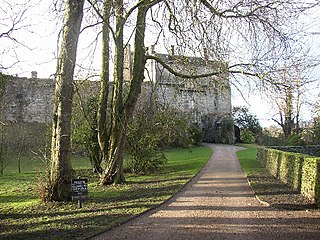
Cockermouth Castle is in the town of Cockermouth in Cumbria on a site by the junction of the Rivers Cocker and Derwent. It is a Grade I listed building and a scheduled monument.

Baynard Castle was a moated castle built in the 12th and 13th centuries in the village of Cottingham, East Riding of Yorkshire, England. It was referred to by terms including the 'castle at Cottingham' or 'Stuteville's castle'; the term Baynard Castle is common in 19th-century references and later.
Driffield Castle is located in the town of Driffield, approximately 12 miles (19 km) north of Beverley, East Riding of Yorkshire, England.

Egremont Castle is located in the town of Egremont, Cumbria.
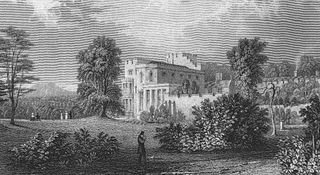
Brougham Hall is a historic house museum located in the village of Brougham just outside Penrith, Cumbria, England.
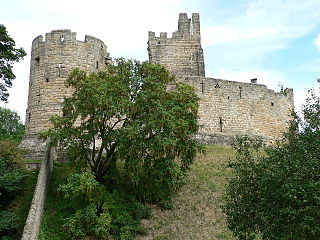
Prudhoe Castle is a ruined medieval English castle situated on the south bank of the River Tyne at Prudhoe, Northumberland, England. It is a Scheduled Ancient Monument and a Grade I listed building.
William de Stuteville Baron of Cottingham in the East Riding of Yorkshire, Lord of Buttercrambe in the North Riding of Yorkshire, was an English noble.
References
- Fry, Plantagenet Somerset, The David & Charles Book of Castles, David & Charles, 1980. ISBN 0-7153-7976-3